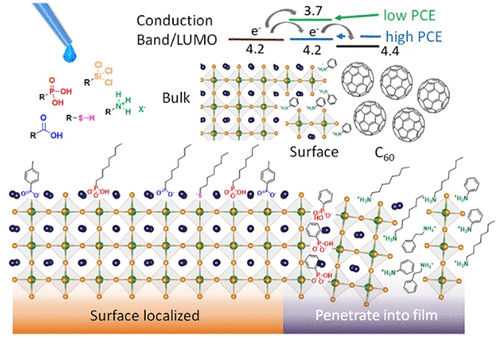当前位置:
X-MOL 学术
›
ACS Energy Lett.
›
论文详情
Our official English website, www.x-mol.net, welcomes your feedback! (Note: you will need to create a separate account there.)
Surface Ligands for Methylammonium Lead Iodide Films: Surface Coverage, Energetics, and Photovoltaic Performance
ACS Energy Letters ( IF 22.0 ) Pub Date : 2020-02-18 , DOI: 10.1021/acsenergylett.0c00054 So Min Park 1, 2 , Ashkan Abtahi 1, 3 , Alex M. Boehm 1 , Kenneth R. Graham 1
ACS Energy Letters ( IF 22.0 ) Pub Date : 2020-02-18 , DOI: 10.1021/acsenergylett.0c00054 So Min Park 1, 2 , Ashkan Abtahi 1, 3 , Alex M. Boehm 1 , Kenneth R. Graham 1
Affiliation

|
Surface ligand treatment provides a promising approach for passivating defect states, improving material and device stability, manipulating interfacial energetics, and improving the performance of perovskite solar cells (PSCs). To facilitate targeted selection and design of surface ligands for PSCs, it is necessary to establish relationships between ligand structure and perovskite surface properties. Herein, surface ligands with different binding groups are investigated to determine their extent of surface coverage, whether they form a surface monolayer or penetrate the perovskite, how they influence material energetics and photoluminescence, and how this combination of factors affects PSC performance. Ultraviolet and inverse photoelectron spectroscopy measurements show that surface ligands can significantly shift the ionization energy and electron affinity. These changes in surface energetics substantially impact PSC performance, with the performance decreasing for ligands that create less favorable energy landscapes for electron transfer from MAPbI3 to the electron transport layer, C60.
中文翻译:

甲基铵碘化铅薄膜的表面配体:表面覆盖率,能量学和光伏性能
表面配体处理为钝化缺陷状态,提高材料和器件的稳定性,操纵界面能,以及改善钙钛矿太阳能电池(PSC)的性能提供了一种有前途的方法。为了促进针对PSC的表面配体的针对性选择和设计,有必要在配体结构和钙钛矿表面性质之间建立关系。在本文中,研究了具有不同结合基团的表面配体,以确定它们的表面覆盖程度,它们是形成表面单层还是穿透钙钛矿,它们如何影响材料的能量和光致发光以及这些因素的组合如何影响PSC性能。紫外和反向光电子能谱测量表明,表面配体可以显着改变电离能和电子亲和力。表面能学的这些变化大大影响了PSC的性能,配体的性能下降,而配体的性能下降,不利于从MAPbI转移电子。3至电子传输层,C 60。
更新日期:2020-02-19
中文翻译:

甲基铵碘化铅薄膜的表面配体:表面覆盖率,能量学和光伏性能
表面配体处理为钝化缺陷状态,提高材料和器件的稳定性,操纵界面能,以及改善钙钛矿太阳能电池(PSC)的性能提供了一种有前途的方法。为了促进针对PSC的表面配体的针对性选择和设计,有必要在配体结构和钙钛矿表面性质之间建立关系。在本文中,研究了具有不同结合基团的表面配体,以确定它们的表面覆盖程度,它们是形成表面单层还是穿透钙钛矿,它们如何影响材料的能量和光致发光以及这些因素的组合如何影响PSC性能。紫外和反向光电子能谱测量表明,表面配体可以显着改变电离能和电子亲和力。表面能学的这些变化大大影响了PSC的性能,配体的性能下降,而配体的性能下降,不利于从MAPbI转移电子。3至电子传输层,C 60。


























 京公网安备 11010802027423号
京公网安备 11010802027423号